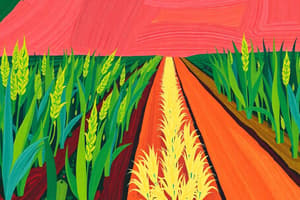Podcast
Questions and Answers
Which of the following crops is NOT considered a root crop?
Which of the following crops is NOT considered a root crop?
- Carrot
- Beet roots
- Ginger
- Potatoes (correct)
Which of the following is an example of a tuberous root?
Which of the following is an example of a tuberous root?
- Carrot
- Sweet potato (correct)
- Ginger
- Sugar beet
What is the main difference between a tuberous root and a fleshy root?
What is the main difference between a tuberous root and a fleshy root?
- Tuberous roots are thickened secondary roots, while fleshy roots are enlarged primary roots. (correct)
- Tuberous roots are edible, while fleshy roots are not edible.
- Tuberous roots grow horizontally, while fleshy roots grow vertically.
- Tuberous roots are found underground, while fleshy roots are found above the ground.
What distinguishes a tuber from a rhizome?
What distinguishes a tuber from a rhizome?
Which of the following is the most widely produced root and tuber crop globally?
Which of the following is the most widely produced root and tuber crop globally?
Which root and tuber crop is considered an 'insurance crop' due to its ability to be grown all year round under suitable climatic conditions?
Which root and tuber crop is considered an 'insurance crop' due to its ability to be grown all year round under suitable climatic conditions?
Which root and tuber crop provides significant amounts of carbohydrates, potassium, and vitamin C in the diet?
Which root and tuber crop provides significant amounts of carbohydrates, potassium, and vitamin C in the diet?
What role do root and tuber crops play in comparison with cereals?
What role do root and tuber crops play in comparison with cereals?
Which root and tuber crop is commonly used in South American, African, and Caribbean cuisine?
Which root and tuber crop is commonly used in South American, African, and Caribbean cuisine?
Which country accounts for approximately 19% of the total global production of cassava?
Which country accounts for approximately 19% of the total global production of cassava?
Study Notes
Root and Tuber Crops
- Root crops are classified into two categories: root vegetables and tubers.
- Tubers, such as potatoes, have swollen ends and produce stems and leaves from the top.
- Fleshy roots, like carrots, grow underground but do not produce stems and leaves.
Types of Root Crops
- Examples of tuberous roots include sweet potatoes and yams.
- Cassava, also known as manioc, is an example of a root crop that is not a root vegetable or tuber.
Characteristics of Tuberous Roots and Fleshy Roots
- The main difference between a tuberous root and a fleshy root is that tuberous roots produce stems and leaves.
- Tuberous roots grow new plants from their "eyes".
Tuber vs. Rhizome
- A tuber is a type of root that grows new plants from its "eyes", whereas a rhizome grows new plants from its nodes.
Global Production of Root and Tuber Crops
- The most widely produced root and tuber crop globally is the potato.
- Cassava accounts for approximately 19% of the total global production.
Importance of Root and Tuber Crops
- Root and tuber crops provide significant amounts of carbohydrates, potassium, and vitamin C in the diet.
- These crops play a crucial role in food security, particularly in tropical regions.
Cultural Significance of Root and Tuber Crops
- Cassava is an 'insurance crop' due to its ability to be grown all year round under suitable climatic conditions.
- Yams are commonly used in South American, African, and Caribbean cuisine.
Studying That Suits You
Use AI to generate personalized quizzes and flashcards to suit your learning preferences.
Description
Test your knowledge of root and tuber crops production and management with this quiz. Learn about the characteristics of root crops and tuber crops, as well as examples of edible root and tuber crops.



